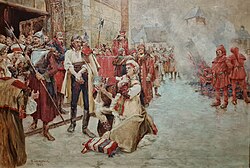
Information to change the world | |
Find Topics, Titles, Names related to your query |

Information to change the world | |
Find Topics, Titles, Names related to your query |
|
|
Croatian-Slovenian peasant revolt
|
| This article needs additional citations for verification. Please help improve this article by adding reliable references. Unsourced material may be challenged and removed. (August 2007) |

The Croatian-Slovenian peasant revolt of 1573 was a large peasant revolt in today's Croatia and Slovenia. The revolt, sparked by cruel treatment of serfs by the baron Franjo Tahy, ended after 12 days with the defeat of the rebels and bloody retribution by the nobility.
Contents |
In the late 16th century, the threat of Ottoman incursions strained the economy of the southern flanks of the Holy Roman Empire, and feudal lords continually increased their demands on the peasantry. In Croatian Zagorje, this was compounded by cruel treatment of peasants by baron Franjo Tahy and his warring with neighbouring barons over land. When multiple complaints to the emperor went unheard, the peasants conspired to rebel with their peers in the neighbouring provinces of Styria and Carniola and with the lower classes of townspeople.
The rebellion broke out simultaneously in large parts of Croatia, Styria, and Carniola on 28 January 1573. The rebels' political program was to replace the nobility with peasant officials answerable directly to the emperor, and to abolish all feudal holdings and obligations of the Roman Catholic Church. A peasant government was formed with Matija Gubec, Ivan Pasanac and Ivan Mogaiä as members. Far-reaching plans were drawn up, including abolition of provincial borders, opening of highways for trade, and self-rule by the peasants.
The captain of the rebels, Ilija Gregoriä, planned an extensive military operation to secure victory for the revolt. Each peasant household provided one man for his army, which met with some initial success; their revolutionary goals alarmed the nobility, however, which raised armies in response.
On 5 February, imperial captain Turn defeated Ilija Gregoriä and 2,000 men near the Lower Styrian town of BreÅice. The next day, another rebel force was subjugated near Samobor. On 9 February, the decisive Battle of Stubiäko polje was fought. Gubec and his 10,000 men resisted fiercely, but after a bloody four-hour battle the baronal army defeated and captured Gubec. The revolt failed.
Retribution was brutal: in addition to the 3,000 peasants who died in the battle, many captives were hanged or maimed. Matija Gubec was publicly tortured and executed on 15 February.
The revolt and torture of Gubec acquired legendary status in Croatia and Slovenia. It has inspired many writers and artists, including the writer Miroslav KrleÅa, the poet Anton AÅ¡kerc and the sculptors Antun Augustinäiä and Stojan Batiä. A museum near OrÅ¡iä Castle in Gornja Stubica and one in KrÅ¡ko (Slovenia) are dedicated to the revolt.
Related topics in the Connexions Subject Index
Alternatives –
Left History –
Libraries & Archives –
Social Change –
This article is based on one or more articles in Wikipedia, with modifications and additional content contributed by
Connexions editors. This article, and any information from Wikipedia, is covered by a
Creative Commons Attribution-Sharealike 3.0 Unported License (CC-BY-SA) and the
GNU Free Documentation
License (GFDL).
We welcome your help in improving and expanding the content of Connexipedia articles, and in correcting errors. Connexipedia is not a wiki: please contact Connexions by email if you wish to contribute. We are also looking for contributors interested in writing articles on topics, persons, events and organizations related to social justice and the history of social change movements.
For more information contact Connexions



